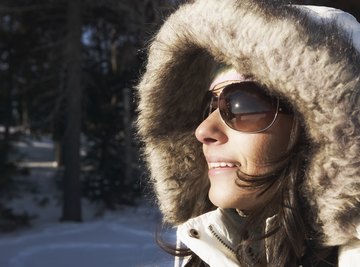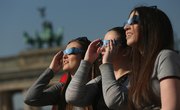
Bright sun reflecting from snow creates beautiful winter landscapes, but sun glare can also damage your health, and cause accidents. Sunlight might not seem a danger in cold, snowy weather, but it can damage your skin and eyes over the short term and long term, and cause car crashes. Skiers and others taking part in winter sports, hikers, drivers and anyone else spending time outside on snowy days should take precautions against sun glare.
Double the Trouble
Snow reflects the sun's rays and increases the risks of sunburn and skin cancer. Sun exposure is high in snowy conditions because snow reflects 80 percent of the sun's rays, and skiers, snowboarders and other s at high altitude are at even greater risk because UV radiation increases 4 to 5 percent every 1,000 feet above sea level. Any exposed skin can burn, including areas under the chin and nose, which are usually in shadow. Cloudy weather offers little protection because sunlight penetrates up to 80 percent of cloud cover. Sun exposure is associated with more than 90 percent of skin cancers. (Ref 1)
Sight for Sore Eyes
Sun glare from snow burns unprotected eyes. Eyes exposed to reflected sunlight develop snow blindness, a painful condition that lasts up to a week and includes extreme sensitivity to light and a feeling of sand in the eyes. Sunburn of the eyes also takes up to a week to heal. Over the long term, eyes regularly exposed to sun glare can develop eye diseases, such as cataracts, age-related blindness, blurred vision and the inability to see at night. Children and people with light-colored eyes are most likely to suffer eye damage. (Ref 2 and 3)
Under the Sun
Specialized eye protection and high factor sunscreen provide protection from sun glare. When outside on a snowy day, wear sunglasses or sun goggles that absorb 95 percent or more UV rays, and a hat with a brim. Polycarbonate lenses help protect the eyes from damage in case of accidents when taking part in winter sports. Apply a factor 30 or higher sunscreen that protects against UVA and UVB rays to all exposed skin 30 minutes before going out. Apply the sunscreen thickly, spreading at least a teaspoon over the face, and cover your lips with factor 15 or higher lip balm. Reapply sunscreen and lip balm at least every two hours, or immediately after heavy sweating. (Ref 1 and 4)
A Safe Trip
Sun glare from snow can temporarily blind drivers, causing traffic accidents. Sunlight reflects from snow on roadways, vehicles and other surfaces. Drivers driving in snowy conditions should keep their windshields clean and windshield washer reservoirs full of cleaning fluid, and avoid using high gloss vinyl cleanser on their dashboards. They should also wear polarized sunglasses with UV protection, allow for additional stopping distance from the car in front, turn on their headlights and lower their visors. Driving routes with tall buildings or trees reduces the risks of sun glare. (Ref 2)
References
About the Author
A graduate of Leeds University, Jenny Green completed Master of Arts in English literature in 1998 and has been writing about science since 2007. Green's work appears in Synonym, Sciencing, and other websites and ezines
Photo Credits
Brand X Pictures/Stockbyte/Getty Images
